Is It Possible to Find an Antimicrobial Peptide That Passes the Membrane Bilayer with Minimal Force Resistance? An Attempt at a Predictive Approach by Molecular Dynamics Simulation
Abstract
:1. Introduction
2. Results
2.1. Studied Amyloidogenic Peptides with Antibacterial Potential and Homo-Repeats
2.2. Construction of Membrane Phospholipid Bilayer
2.3. MD Simulations
2.4. Division of Peptides into Groups According to the Force Reaction of the Membrane
2.5. Phospholipid Pulling
3. Materials and Methods
3.1. Description of the Task
- (1)
- Construction of phospholipid bilayers with peptides;
- (2)
- Carrying out MD experiments on peptide pulling (across a bilayer) at constant rates of 0.1, 0.5, and 0.01 Å/ps
- (a)
- by terminal atom (8 numerical experiments for each peptide),
- (b)
- by the center of mass of peptide;
- (3)
- Collection and processing of statistical data for all experiments.
3.2. Software and Md-Simulation
3.3. Construction of Phospholipid Bilayers with Peptides
- Construct 8 copies of the phospholipid molecule (multiplication) along with the OY axis (directed upwards relative to the plane of the paper).
- Construct 8 copies of the resulting system (multiplication) along the OZ axis (perpendicular to the plane of the sheet of paper). Thus, one layer of phospholipids, 8 × 8 = 64 molecules, was obtained.
- Construct a copy of the resulting system, and then its rotation by 180 degrees around the OY axis, placing the resulting layer tail to tail (Figure 2). Reflection is not suitable in this case, since it will change the topology of the molecules.
- Fill the system with a peptide with a given amino acid sequence, constructed using the PyMol molecular constructor. The first amino acid residue is preceded by a hydrogen molecule, and the last is preceded by an OH group covering the free valences. The resulting peptide is shown in Table 1.
- To simulate real conditions, a solvent (water) is added to the system. The number of molecules corresponds to the possibility of calculating molecular dynamics under periodic boundary conditions, with a parallelepiped as a calculation cell (Figure 3).
- The relaxation of each system (with different peptides) is carried out in the PUMA-CUDA software package for 1 ns in the NVT ensemble, with calculation of the computational cell size of those obtained in step 6.
3.4. Force Effects
3.5. Samples
4. Conclusions
Supplementary Materials
Author Contributions
Funding
Institutional Review Board Statement
Informed Consent Statement
Data Availability Statement
Acknowledgments
Conflicts of Interest
Abbreviations
| a.a. | amino acid |
| AMP | antimicrobial peptide |
| POPC | 1-palmitoyl-2-oleoyl-sn-glycero-3-phosphatidylcholine |
| ThT | thioflavin T |
References
- Bechinger, B. A Dynamic View of Peptides and Proteins in Membranes. Cell Mol. Life Sci. 2008, 65, 3028–3039. [Google Scholar] [CrossRef] [PubMed]
- Rabinovich, A.L.; Ripatti, P.O. Polyunsaturated Hydrocarbon Chains of Lipids: Structure, Properties, Functions. Successes Mod. Biol. 1996, 114, 581–594. [Google Scholar]
- Liu, L.P.; Deber, C.M. Anionic Phospholipids Modulate Peptide Insertion into Membranes. Biochemistry 1997, 36, 5476–5482. [Google Scholar] [CrossRef] [PubMed]
- Slaybaugh, G.; Weerakkody, D.; Engelman, D.M.; Andreev, O.A.; Reshetnyak, Y.K. Kinetics of PHLIP Peptide Insertion into and Exit from a Membrane. Proc. Natl. Acad. Sci. USA 2020, 117, 12095–12100. [Google Scholar] [CrossRef]
- Saar-Dover, R.; Ashkenazi, A.; Shai, Y. Peptide Interaction with and Insertion into Membranes. Methods Mol. Biol. 2013, 1033, 173–183. [Google Scholar] [CrossRef]
- Calvez, P.; Bussières, S.; Demers, E.; Salesse, C. Parameters Modulating the Maximum Insertion Pressure of Proteins and Peptides in Lipid Monolayers. Biochimie 2009, 91, 718–733. [Google Scholar] [CrossRef]
- Aghazadeh, H.; Ganjali Koli, M.; Ranjbar, R.; Pooshang Bagheri, K. Interactions of GF-17 Derived from LL-37 Antimicrobial Peptide with Bacterial Membranes: A Molecular Dynamics Simulation Study. J. Comput. Aided Mol. Des. 2020, 34, 1261–1273. [Google Scholar] [CrossRef]
- Kubiak-Ossowska, K.; Burley, G.; Patwardhan, S.V.; Mulheran, P.A. Spontaneous Membrane-Translocating Peptide Adsorption at Silica Surfaces: A Molecular Dynamics Study. J. Phys. Chem. B 2013, 117, 14666–14675. [Google Scholar] [CrossRef] [Green Version]
- Quan, X.; Sun, D.; Zhou, J. Molecular Mechanism of HIV-1 TAT Peptide and Its Conjugated Gold Nanoparticles Translocating across Lipid Membranes. Phys. Chem. Chem. Phys. 2019, 21, 10300–10310. [Google Scholar] [CrossRef]
- Gandhi, N.S.; Blancafort, P.; Mancera, R.L. Atomistic Molecular Dynamics Simulations of Bioactive Engrailed 1 Interference Peptides (EN1-IPeps). Oncotarget 2018, 9, 22383–22397. [Google Scholar] [CrossRef]
- Panina, I.; Krylov, N.; Nolde, D.; Efremov, R.; Chugunov, A. Environmental and Dynamic Effects Explain How Nisin Captures Membrane-Bound Lipid II. Sci. Rep. 2020, 10, 8821. [Google Scholar] [CrossRef] [PubMed]
- Her Choong, F.; Keat Yap, B. Cell-Penetrating Peptides: Correlation between Peptide-Lipid Interaction and Penetration Efficiency. Chemphyschem 2021, 22, 493–498. [Google Scholar] [CrossRef] [PubMed]
- Albrecht, C.; Appert-Collin, A.; Bagnard, D.; Blaise, S.; Romier-Crouzet, B.; Efremov, R.G.; Sartelet, H.; Duca, L.; Maurice, P.; Bennasroune, A. Transmembrane Peptides as Inhibitors of Protein-Protein Interactions: An Efficient Strategy to Target Cancer Cells? Front. Oncol. 2020, 10, 519. [Google Scholar] [CrossRef] [PubMed] [Green Version]
- Hata, H.; Nishiyama, M.; Kitao, A. Molecular Dynamics Simulation of Proteins under High Pressure: Structure, Function and Thermodynamics. Biochim. Biophys. Acta 2020, 1864, 129395. [Google Scholar] [CrossRef] [PubMed]
- Grasso, G.; Muscat, S.; Rebella, M.; Morbiducci, U.; Audenino, A.; Danani, A.; Deriu, M.A. Cell Penetrating Peptide Modulation of Membrane Biomechanics by Molecular Dynamics. J. Biomech. 2018, 73, 137–144. [Google Scholar] [CrossRef]
- de Oliveira, E.C.L.; da Costa, K.S.; Taube, P.S.; Lima, A.H.; Junior, C.d.S.d.S. Biological Membrane-Penetrating Peptides: Computational Prediction and Applications. Front. Cell. Infect. Microbiol. 2022, 12, 838259. [Google Scholar] [CrossRef]
- Lee, C.T.; Comer, J.; Herndon, C.; Leung, N.; Pavlova, A.; Swift, R.V.; Tung, C.; Rowley, C.N.; Amaro, R.E.; Chipot, C.; et al. Simulation-Based Approaches for Determining Membrane Permeability of Small Compounds. J. Chem. Inf. Model. 2016, 56, 721–733. [Google Scholar] [CrossRef] [Green Version]
- Reid, L.M.; Verma, C.S.; Essex, J.W. The Role of Molecular Simulations in Understanding the Mechanisms of Cell-Penetrating Peptides. Drug Discov. Today 2019, 24, 1821–1835. [Google Scholar] [CrossRef]
- Venable, R.M.; Krämer, A.; Pastor, R.W. Molecular Dynamics Simulations of Membrane Permeability. Chem. Rev. 2019, 119, 5954–5997. [Google Scholar] [CrossRef]
- Bogdanova, L.R.; Valiullina, Y.A.; Faizullin, D.A.; Kurbanov, R.K.; Ermakova, E.A. Spectroscopic, Zeta Potential and Molecular Dynamics Studies of the Interaction of Antimicrobial Peptides with Model Bacterial Membrane. Spectrochim. Acta A Mol. Biomol. Spectrosc. 2020, 242, 118785. [Google Scholar] [CrossRef]
- Tourleigh, Y.V.; Shaitan, K.V.; Balabaev, N.K. Diffusion of Molecules at the Interface of Water-Membrane Structures. Defect and Diffusion Forum 2007, 261–262, 109–126. [Google Scholar] [CrossRef]
- Sugita, M.; Sugiyama, S.; Fujie, T.; Yoshikawa, Y.; Yanagisawa, K.; Ohue, M.; Akiyama, Y. Large-Scale Membrane Permeability Prediction of Cyclic Peptides Crossing a Lipid Bilayer Based on Enhanced Sampling Molecular Dynamics Simulations. J. Chem. Inf. Model. 2021, 61, 3681–3695. [Google Scholar] [CrossRef] [PubMed]
- Kurpe, S.R.; Grishin, S.Y.; Surin, A.K.; Selivanova, O.M.; Fadeev, R.S.; Dzhus, U.F.; Gorbunova, E.Y.; Mustaeva, L.G.; Azev, V.N.; Galzitskaya, O.V. Antimicrobial and Amyloidogenic Activity of Peptides Synthesized on the Basis of the Ribosomal S1 Protein from Thermus Thermophilus. Int. J. Mol. Sci. 2020, 21, E6382. [Google Scholar] [CrossRef] [PubMed]
- Grishin, S.Y.; Deryusheva, E.I.; Machulin, A.V.; Selivanova, O.M.; Glyakina, A.V.; Gorbunova, E.Y.; Mustaeva, L.G.; Azev, V.N.; Rekstina, V.V.; Kalebina, T.S.; et al. Amyloidogenic Propensities of Ribosomal S1 Proteins: Bioinformatics Screening and Experimental Checking. Int. J. Mol. Sci. 2020, 21, 5199. [Google Scholar] [CrossRef]
- Swiss Mass Abacus—SIB Swiss Institute of Bioinformatics|Expasy. Available online: https://www.expasy.org/resources/swiss-mass-abacus (accessed on 4 August 2021).
- Wilkins, M.R.; Lindskog, I.; Gasteiger, E.; Bairoch, A.; Sanchez, J.C.; Hochstrasser, D.F.; Appel, R.D. Detailed Peptide Characterization Using PEPTIDEMASS--a World-Wide-Web-Accessible Tool. Electrophoresis 1997, 18, 403–408. [Google Scholar] [CrossRef]
- Pirtskhalava, M.; Amstrong, A.A.; Grigolava, M.; Chubinidze, M.; Alimbarashvili, E.; Vishnepolsky, B.; Gabrielian, A.; Rosenthal, A.; Hurt, D.E.; Tartakovsky, M. DBAASP v3: Database of Antimicrobial/Cytotoxic Activity and Structure of Peptides as a Resource for Development of New Therapeutics. Nucleic Acids Res. 2021, 49, D288–D297. [Google Scholar] [CrossRef]
- Guruprasad, K.; Reddy, B.V.; Pandit, M.W. Correlation between Stability of a Protein and Its Dipeptide Composition: A Novel Approach for Predicting in Vivo Stability of a Protein from Its Primary Sequence. Protein Eng. 1990, 4, 155–161. [Google Scholar] [CrossRef]
- Lemak, A.S.; Balabaev, N.K. A Comparison Between Collisional Dynamics and Brownian Dynamics. Mol. Simul. 1995, 15, 223–231. [Google Scholar] [CrossRef]
- Lemak, A.S.; Balabaev, N.K. Molecular Dynamics Simulation of a Polymer Chain in Solution by Collisional Dynamics Method. J. Comput. Chem. 1996, 17, 1685–1695. [Google Scholar] [CrossRef]
- Glyakina, A.V.; Balabaev, N.K.; Galzitskaya, O.V. Determination of the Most Stable Packing of Peptides from Ribosomal S1 Protein, Protein Bgl2p, and Aβ Peptide in β-Layers During Molecular Dynamics Simulations. Methods Mol. Biol. 2022, 2340, 221–233. [Google Scholar] [CrossRef]
- Glyakina, A.V.; Likhachev, I.V.; Balabaev, N.K.; Galzitskaya, O.V. Comparative Mechanical Unfolding Studies of Spectrin Domains R15, R16 and R17. J. Struct. Biol. 2018, 201, 162–170. [Google Scholar] [CrossRef] [PubMed]
- Glyakina, A.V.; Likhachev, I.V.; Balabaev, N.K.; Galzitskaya, O.V. Mechanical Stability Analysis of the Protein L Immunoglobulin-Binding Domain by Full Alanine Screening Using Molecular Dynamics Simulations. Biotechnol. J. 2015, 10, 386–394. [Google Scholar] [CrossRef] [PubMed]
- Glyakina, A.V.; Balabaev, N.K.; Galzitskaya, O.V. Mechanical Unfolding of Proteins L and G with Constant Force: Similarities and Differences. J. Chem. Phys. 2009, 131, 45102. [Google Scholar] [CrossRef] [PubMed]
- Wang, J.; Cieplak, P.; Kollman, P.A. How well does a restrained electrostatic potential (RESP) model perform in calculating conformational energies of organic and biological molecules? J. Comput. Chem. 2000, 21, 1049–1074. [Google Scholar] [CrossRef]
- Mahoney, M.W.; Jorgensen, W.L. A Five-Site Model for Liquid Water and the Reproduction of the Density Anomaly by Rigid, Nonpolarizable Potential Functions. J. Chem. Phys. 2000, 112, 8910–8922. [Google Scholar] [CrossRef]
- Albrecht, C.; Kuznetsov, A.S.; Appert-Collin, A.; Dhaideh, Z.; Callewaert, M.; Bershatsky, Y.V.; Urban, A.S.; Bocharov, E.V.; Bagnard, D.; Baud, S.; et al. Transmembrane Peptides as a New Strategy to Inhibit Neuraminidase-1 Activation. Front. Cell Dev. Biol. 2020, 8, 611121. [Google Scholar] [CrossRef]
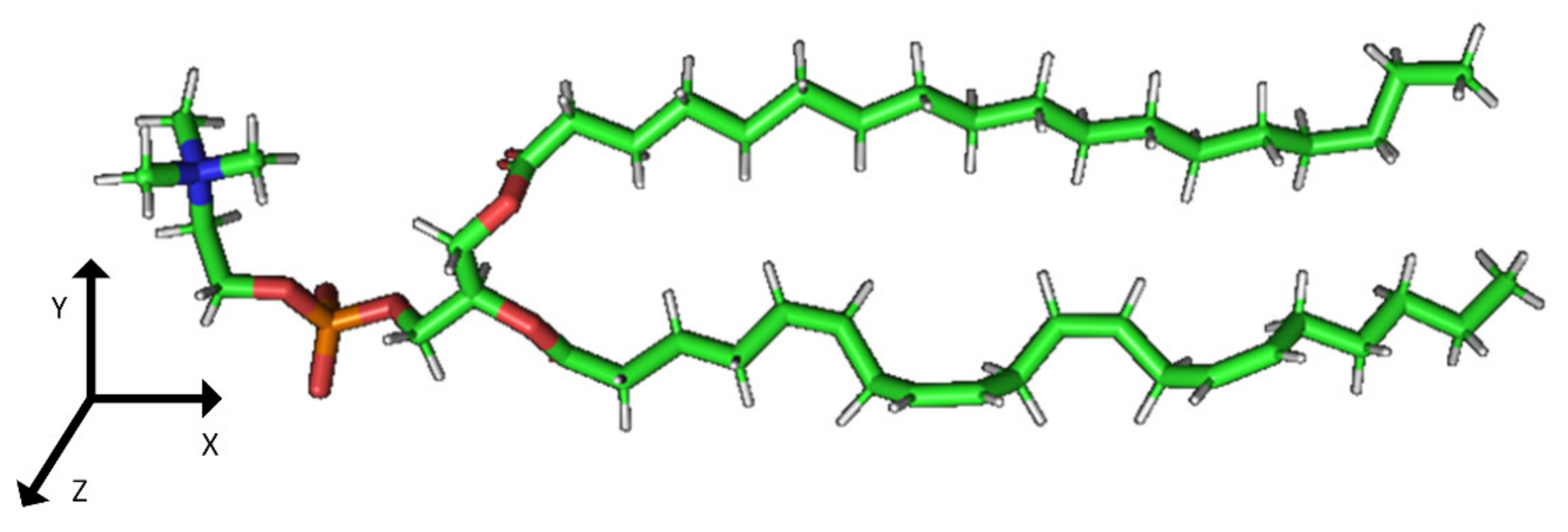

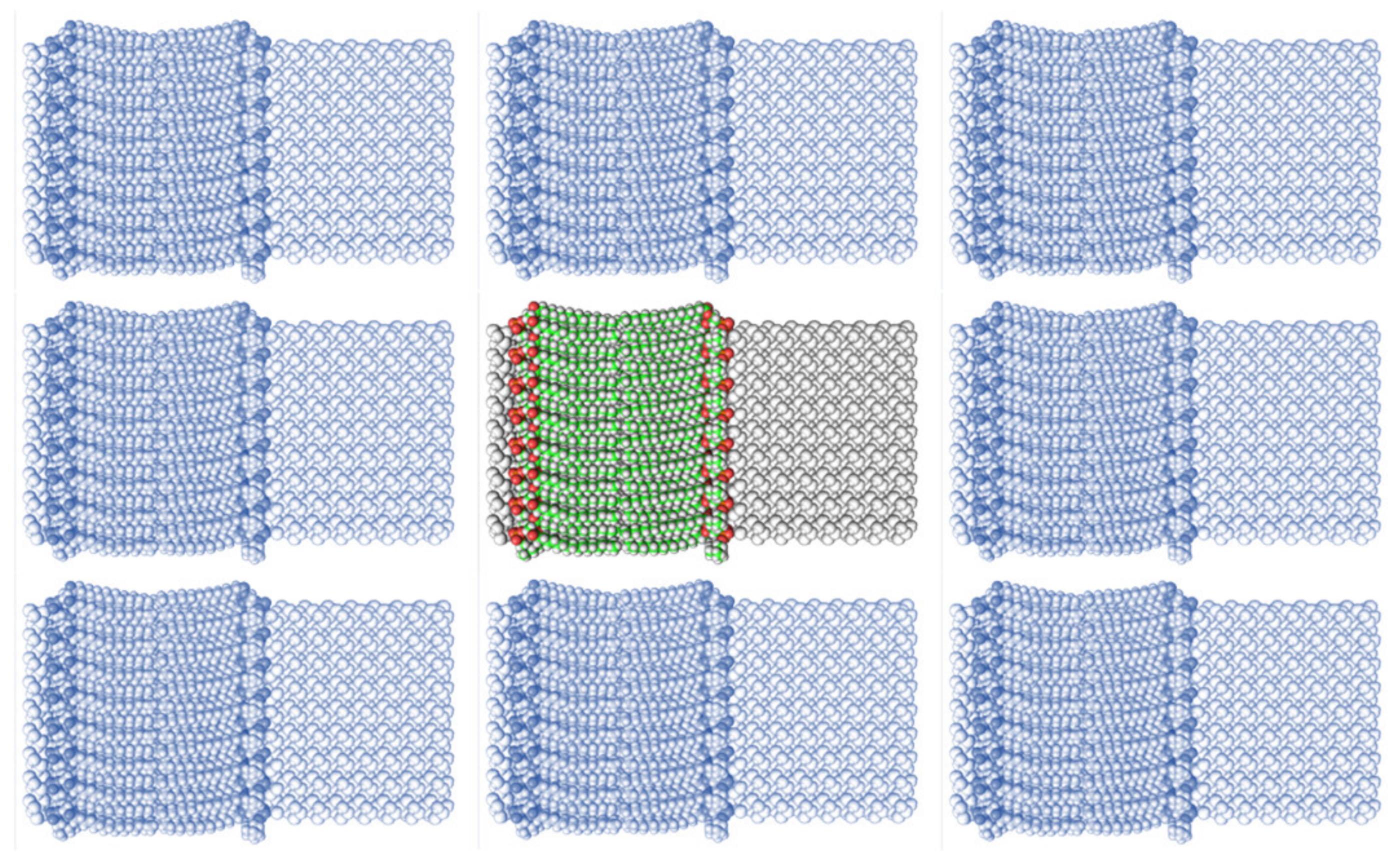
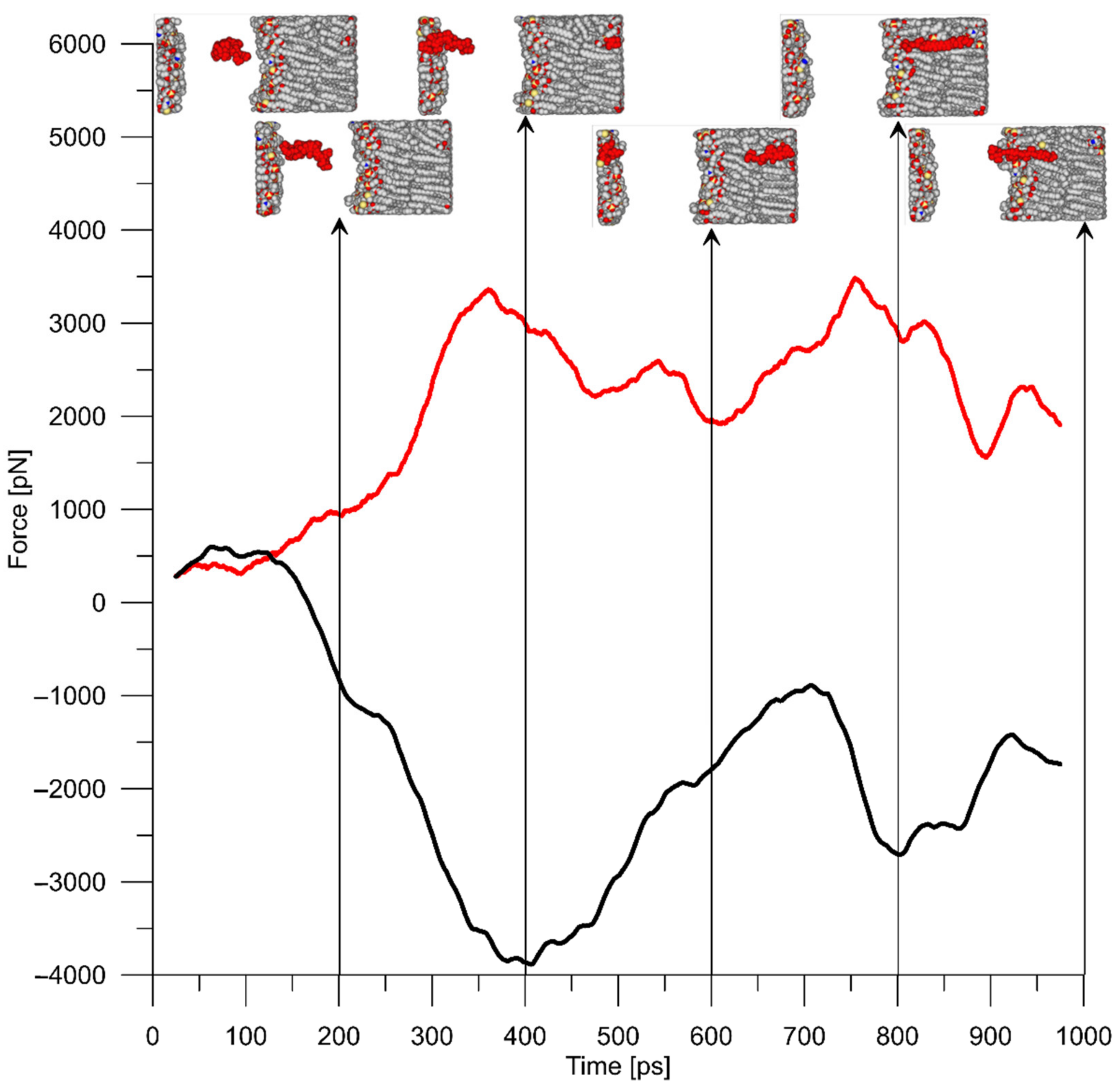
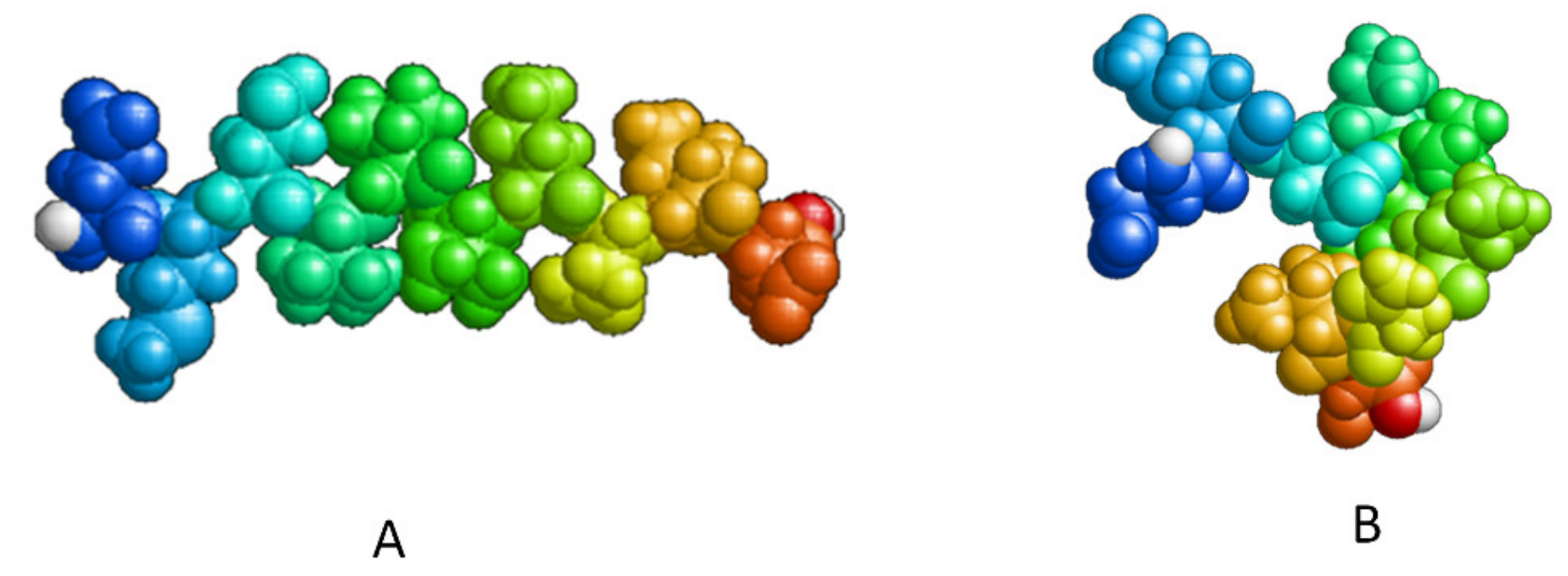
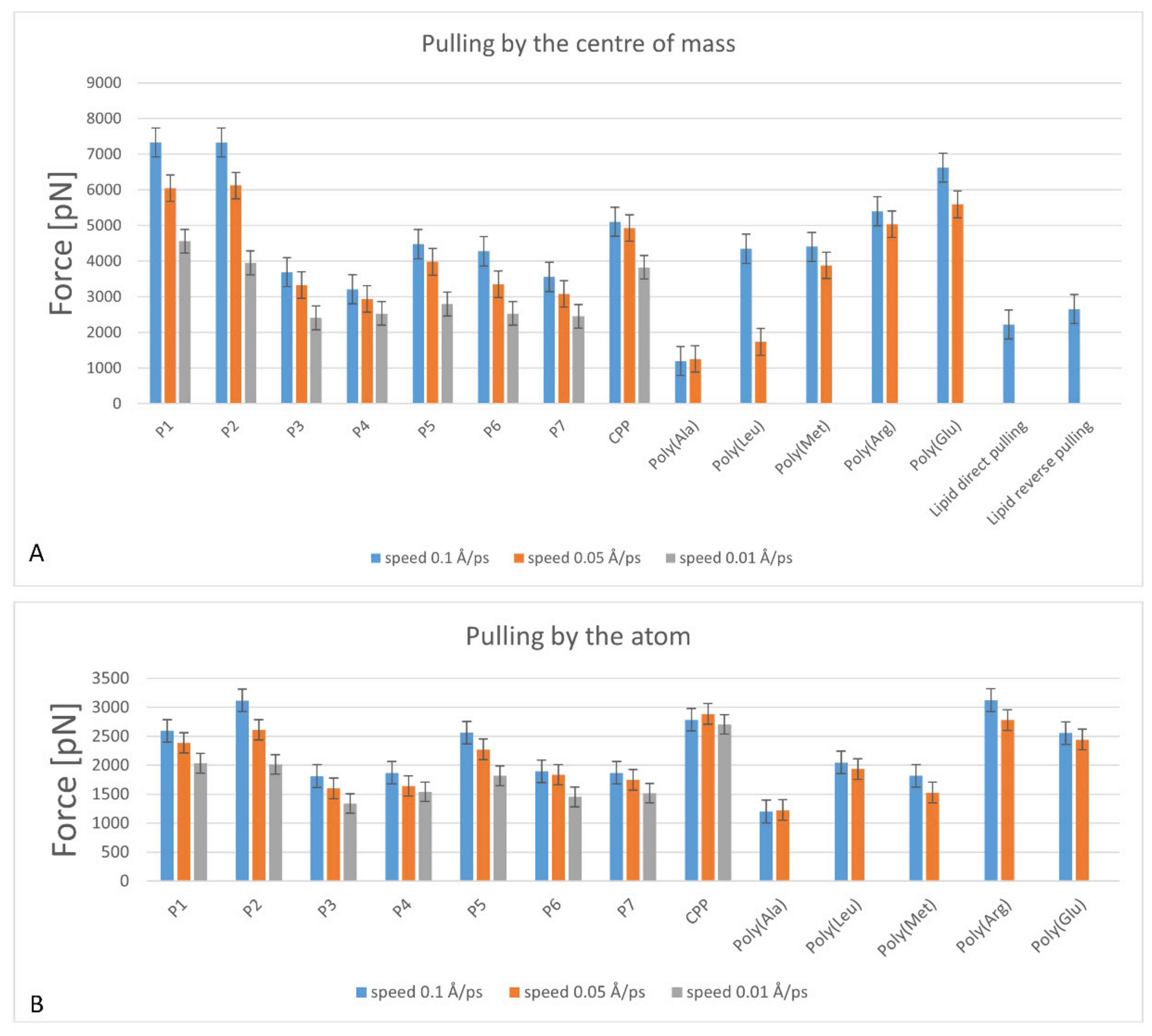
| Amino Acid Sequence, Localization in Protein and Domain (D), Organism, MW *, Pi ** 3D Structures of the Peptides in the Extended Conformation | Localization in 3D Structure | The Ability of a Peptide to Form Amyloid Fibrils According to the Fluorescence Intensity of Thioflavin T and Electron Microscopy under Condition of 50 mM TrisHCl, pH 7.5; 150 mM NaCl, 1–8 h of Incubation [24] |
|---|---|---|
| P1, Peptide 1, RKKRRQRRRGGAGVTDFGVFVEI (R23I) T VTDFGVFVEI (V10I) T; this fragment is colored in the 3D structure (391–400 a.a.), D5, T. thermophilus 2689.1, 12 | 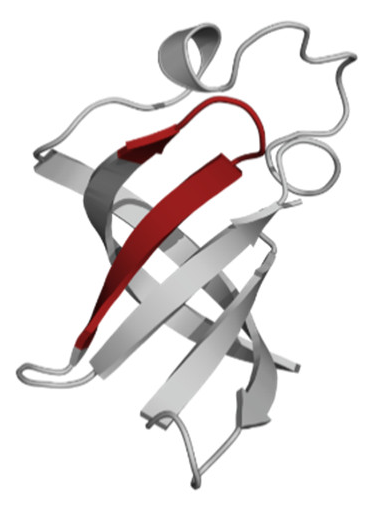 | According to the data of fluorescence spectroscopy: the initial low intensity of ThT fluorescence (up to 2 relative units) does not change significantly, which indicates the absence of amyloids in the preparation of the R23I peptide. Aggregates of different sizes and aggregates of such aggregates were observed using electron microscopy (EM). |
| P2, Peptide 2, EMEVVVLNID (E10D) T, (430–439), D5, T. thermophilus, 1160.3, 3.4  | 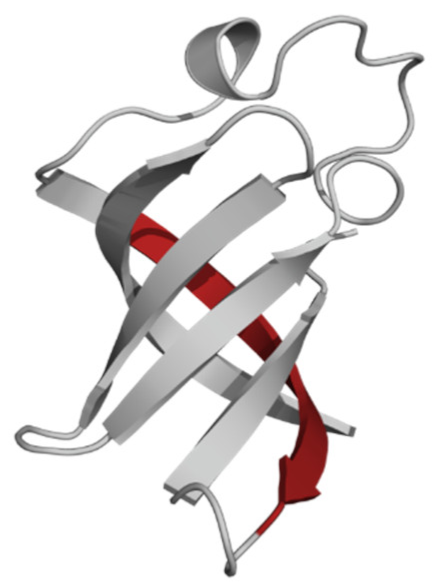 | The ThT fluorescence spectrum does not allow for revealing a characteristic increase in fluorescence intensity for ThT bound to amyloid aggregates. According to EM data, the peptide does not form fibrils. Aggregates of different sizes are visible. According to EM data, the peptide forms polymers in the form of short films with a certain height under conditions of 20% acetic acid (pH 2), 150 mM NaCl, 37 °C, incubation time 3 h. Such polymers are collected in aggregates. |
| P3, Peptide 3, DFGVFVNLG (D9G) T, (221–229 a.a.), D3, T. thermophilus 967.1, 3.8 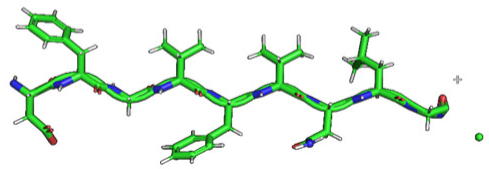 | 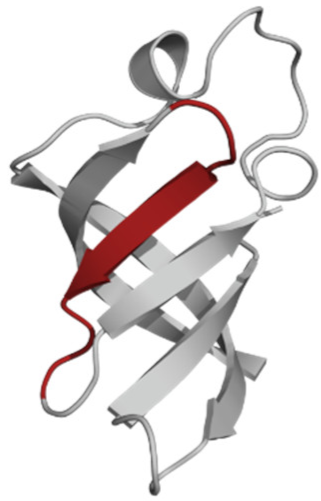 | According to the data of fluorescence spectroscopy, an increase in the ThT fluorescence intensity, which increases to 1000 relative units, indicates the presence of amyloids in the peptide preparation. According to EM data, the peptide forms fibrils of different morphology and length. |
| P4, Peptide 4, IVRGVVVAID (I10D) E, (23–32 a.a.), D1, E. coli 1040.3, 6.3 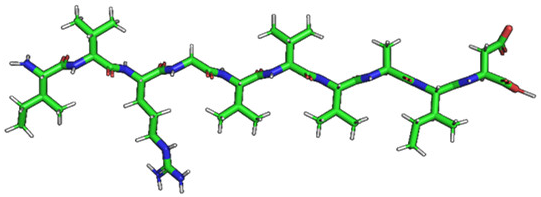 | 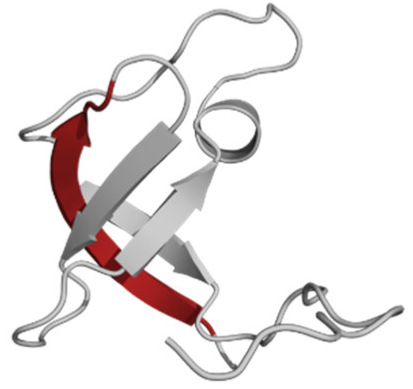 | According to the data of fluorescence spectroscopy, the initial high intensity of ThT fluorescence, which decreases to 40 relative units, indicates the presence of amyloids in the peptide preparation. According to EM data, the peptide forms fibrils in the form of small bundles, or spherulins. |
| P5, Peptide 5, DEITVKVLKF (D10F) E, 3 (239–248 a.a.), D3, E. coli 1191.4, 6.3  |  | According to the fluorescence spectroscopy data, an increase in the ThT fluorescence intensity, which increases to 60 relative units, indicates the presence of amyloids in the peptide preparation. According to EM data, the peptide forms pre-fibrils. An increase in incubation time leads to the formation of mature fibrils. |
| P6, Peptide 6, VVEGTVVEVT (V10T) T, (211–220 a.a), D3, T. thermophilus 1031.2, 3.5  |  | According to the fluorescence spectroscopy data, the initial intensity of ThT fluorescence, which decreases from 12 to 4 relative units, indicates the presence of amyloids (which tend to disaggregate) in the peptide preparation. According to EM data: the peptide forms fibrils in the form of small bundles, which are rare. There are many short pre-fibrils/fibrils. |
| P7, Peptide 7, VTDFGVFVEI (V10I) T, (391–400 a.a.), D5, T. thermophilus 1125.3, 3.5  | 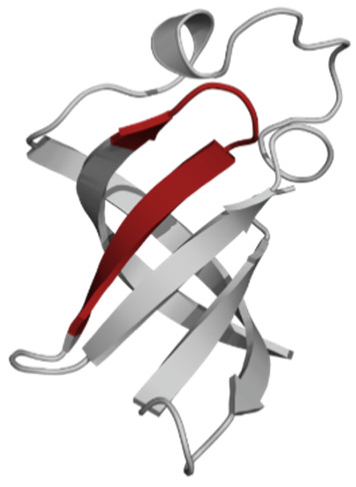 | According to the fluorescence spectroscopy data, the initial high intensity of ThT fluorescence, which increases with time, indicates the presence of amyloids in the peptide preparation. According to EM data, the peptide forms fibrils in the form of small bundles and ribbons, which are rare. There are many short pre-fibrils/fibrils. |
| Peptide | Velocity 0.1 Å/ps | Velocity 0.05 Å/ps | Velocity 0.01 Å/ps |
|---|---|---|---|
| P1 | 7328/2595 | 6049/2388 | 4561/2035 |
| P2 | 7329/3119 | 6123/2613 | 3955/2017 |
| P3 | 3689/1813 | 3325/1602 | 2414/1338 |
| P4 | 3209/1869 | 2944/1642 | 2532/1541 |
| P5 | 4476/2785 | 3983/2886 | 2800/2704 |
| P6 | 4277/1897 | 3357/1837 | 2533/1454 |
| P7 | 3559/1870 | 3086/1748 | 2454/1518 |
| CPP | 5107/2785 | 4934/2886 | 3828/2704 |
| Poly (Ala) | 1201/1201 | 1258/1226 | – |
| Poly (Leu) | 4347/2048 | 1735/1936 | – |
| Poly (Met) | 4405/1819 | 3880/1529 | – |
| Poly (Arg) | 5402/3124 | 5040/2779 | – |
| Poly (Glu) | 6621/2557 | 5594/2444 | – |
| Lipid direct pulling | 2218/- | – | – |
| Lipid reverse pulling | 2655/- | – | – |
Publisher’s Note: MDPI stays neutral with regard to jurisdictional claims in published maps and institutional affiliations. |
© 2022 by the authors. Licensee MDPI, Basel, Switzerland. This article is an open access article distributed under the terms and conditions of the Creative Commons Attribution (CC BY) license (https://creativecommons.org/licenses/by/4.0/).
Share and Cite
Likhachev, I.V.; Balabaev, N.K.; Galzitskaya, O.V. Is It Possible to Find an Antimicrobial Peptide That Passes the Membrane Bilayer with Minimal Force Resistance? An Attempt at a Predictive Approach by Molecular Dynamics Simulation. Int. J. Mol. Sci. 2022, 23, 5997. https://doi.org/10.3390/ijms23115997
Likhachev IV, Balabaev NK, Galzitskaya OV. Is It Possible to Find an Antimicrobial Peptide That Passes the Membrane Bilayer with Minimal Force Resistance? An Attempt at a Predictive Approach by Molecular Dynamics Simulation. International Journal of Molecular Sciences. 2022; 23(11):5997. https://doi.org/10.3390/ijms23115997
Chicago/Turabian StyleLikhachev, Ilya V., Nikolay K. Balabaev, and Oxana V. Galzitskaya. 2022. "Is It Possible to Find an Antimicrobial Peptide That Passes the Membrane Bilayer with Minimal Force Resistance? An Attempt at a Predictive Approach by Molecular Dynamics Simulation" International Journal of Molecular Sciences 23, no. 11: 5997. https://doi.org/10.3390/ijms23115997
APA StyleLikhachev, I. V., Balabaev, N. K., & Galzitskaya, O. V. (2022). Is It Possible to Find an Antimicrobial Peptide That Passes the Membrane Bilayer with Minimal Force Resistance? An Attempt at a Predictive Approach by Molecular Dynamics Simulation. International Journal of Molecular Sciences, 23(11), 5997. https://doi.org/10.3390/ijms23115997







